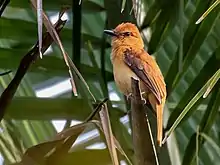Cinnamon attila
The cinnamon attila (Attila cinnamomeus) is a species of bird in the family Tyrannidae, the tyrant flycatchers. It is found in northern South America in the Amazon Basin of Brazil and the Guianas. It is found in Brazil, Colombia, Venezuela, Guyana, Suriname, and French Guiana; also Amazonian Ecuador, Peru, and regions of Bolivia. Its natural habitat is subtropical or tropical swamps.
| Cinnamon attila | |
|---|---|
 | |
| Scientific classification | |
| Domain: | Eukaryota |
| Kingdom: | Animalia |
| Phylum: | Chordata |
| Clade: | Dinosauria |
| Class: | Aves |
| Order: | Passeriformes |
| Family: | Tyrannidae |
| Genus: | Attila |
| Species: | A. cinnamomeus |
| Binomial name | |
| Attila cinnamomeus (Gmelin, JF, 1789) | |
 | |
Taxonomy
The cinnamon attila was formally described in 1789 by the German naturalist Johann Friedrich Gmelin in his revised and expanded edition of Carl Linnaeus's Systema Naturae. He placed it with the flycatchers in the genus Muscicapa and coined the binomial name Muscicapa cinnamomea.[2][3] Gmelin based his description on the "cinnamon flycatcher" that had been described in 1783 by the English ornithologist John Latham in his book A General Synopsis of Birds. Latham had access to a specimen from Cayenne in the Leverian Museum in London.[4] The cinnamon attila is now one of seven flycatchers placed in the genus Attila that was introduced in 1831 by the French naturalist René Lesson.[5] The species is monotypic: no subspecies are recognised.[5] A molecular genetic study published in 2020 found that the cinnamon attila is sister to the rufous-tailed attila (Attila phoenicurus).[6]
Distribution
The cinnamon attila is found in one contiguous range centered on the Amazon Basin. In the southwest it is at the Basin's headwaters in Ecuador and Peru; in northwest Bolivia it is centered on headwater tributaries of the Amazon's Madeira River; in Bolivia's northeast it is only on the headwaters of the Guapore, (on the Brazil-Bolivia border), but not on downstream sections, that flow into the Madeira.
Northwest of the Amazon Basin the continuous range extends into central and northeastern Colombia. In southeastern Venezuela, the cinnamon attila range occurs on the upper Orinoco River drainage; it continues into eastern and northeastern Venezuela and the Guianas, avoiding only the central Orinoco. Its range stays contiguous along the Caribbean coast through the Guianas and only ends south and southeast of the Amazon River outlet with Marajo Island, and the outlet of the downstream Tocantins River, in the northeastern Brazilian state of Maranhão on the Atlantic coast.
References
- BirdLife International (2016). "Attila cinnamomeus". IUCN Red List of Threatened Species. 2016: e.T22700337A93769787. doi:10.2305/IUCN.UK.2016-3.RLTS.T22700337A93769787.en. Retrieved 12 November 2021.
- Gmelin, Johann Friedrich (1789). Systema naturae per regna tria naturae : secundum classes, ordines, genera, species, cum characteribus, differentiis, synonymis, locis (in Latin). Vol. 1, Part 2 (13th ed.). Lipsiae [Leipzig]: Georg. Emanuel. Beer. p. 937.
- Traylor, Melvin A. Jr, ed. (1979). Check-List of Birds of the World. Vol. 8. Cambridge, Massachusetts: Museum of Comparative Zoology. p. 187.
- Latham, John (1783). A General Synopsis of Birds. Vol. 2, Part 1. London: Printed for Leigh and Sotheby. p. 354, No. 56.
- Gill, Frank; Donsker, David; Rasmussen, Pamela, eds. (January 2023). "Tyrant flycatchers". IOC World Bird List Version 13.1. International Ornithologists' Union. Retrieved 21 March 2023.
- Harvey, M.G.; et al. (2020). "The evolution of a tropical biodiversity hotspot". Science. 370 (6522): 1343–1348. doi:10.1126/science.aaz6970. hdl:10138/329703. A high resolution version of the phylogenetic tree in Figure 1 is available from the first author's website here.
External links
- Cinnamon attila videos on the Internet Bird Collection
- Cinnamon attila photo gallery VIREO Photo-High Res
- Photo-High Res; Article oiseaux
- Photo-Medium Res; Article & analysis www.nsf.gov
